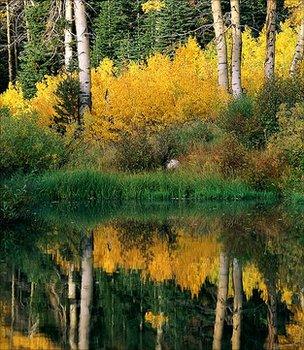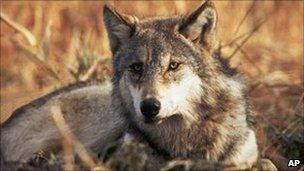Wolf re-introduction fails to stop elks eating aspens
- Published

Aspen is a fast-growing species of tree that can reach 30m in height
The re-introduction of wolves in a US National Park has not helped re-establish quaking aspens, as many researchers had hoped.
Writing in the journal Ecology, a team of scientists found that wolves in Yellowstone Park were not deterring elk from eating young trees.
It had been assumed that the presence of wolves would create a "landscape of fear" and no-go areas for elk.
The team says more work must be done if the park's aspens are to be protected.
Writing in the Ecological Society of America's journal, the researchers added that conventional wisdom suggested that as the wolves were predators of the elk, the elk would eventually learn to avoid the high-risk areas in which wolves were found.
This would then allow plants in those areas - such as aspen - to grow without being eaten and, over the long-term, the habitat would be be able to regenerate.
"Predators indirectly influence plants in two main ways," the team wrote. "By altering either the density or the foraging behaviour of the herbivores."
Crying wolf
Since the early part of the 20th Century, wolves were removed from much of their natural range in North America as a result of hunting, which allowed elk numbers to increase.

Wolves were re-introduced to the region in 1995 to help reduce elk numbers
"The reintroduction of wolves to Yellowstone beginning in 1995 was heralded as a great success, not only because it re-established an extirpated species, but because it was expected to restore ecosystem function through cascading indirect effects on other species," the researchers said.
While elk numbers did decline, the team concluded that there had not been a noticeable change in the foraging behaviour of the animals.
Lead author Matthew Kauffman - a US Geological Survey scientist - suggested the findings showed that claims of an ecosystem-wide recovery of aspen were premature.
"This study not only confirms that elk are responsible for the decline of aspen in Yellowstone beginning in the 1890s, but also that none of the aspen groves studied after wolf restoration (in the mid-1990s) appear to be regenerating, even in areas risky to elk," Dr Kauffman explained.
Because the "landscape of fear" idea did not appear to be benefiting aspen, the team concluded that if the Northern Range elk population did not continue to decline (their numbers are 40% of what they were before wolves were re-introduced), many of Yellowstone's aspen stands were unlikely to recover.
Quaking aspen (Populus tremuloides) is a native species to North America, and its common name is derived from the leaves "quaking" in the slightest breeze, as a result of the species' flattened leaf stalk.
The species is credited with being among the oldest and heaviest land organisms because it propagates primarily via root sprouts, forming extensive clonal colonies.
However, there has been a marked die-back of many aspen groves, which have been attributed to overgrazing - especially in highland areas where grass is in limited supply for animals such as cattle and elk.
Another theory suggests that wildfire suppression policies could be limiting new growth, as the species is a fast-growing tree that is able to capitalise on the open space created by natural fires.
But Dr Kauffman observed: "A landscape-level aspen recovery is likely only to occur if wolves, in combination with other predators and climate factors, further reduce the elk population."
- Published18 August 2010